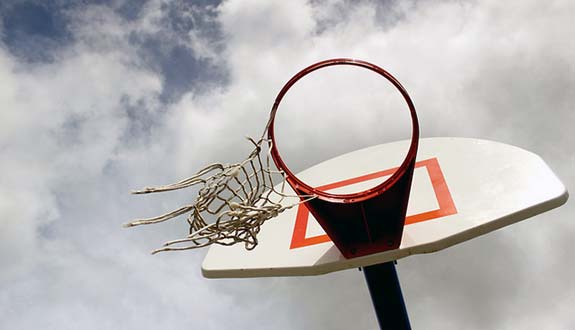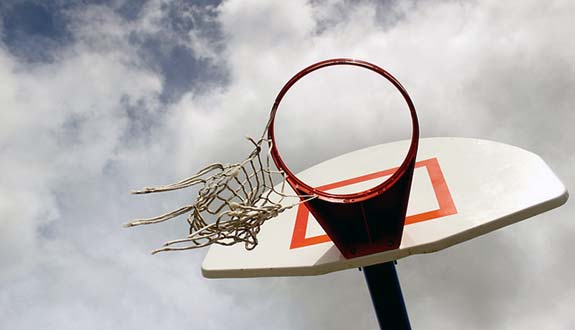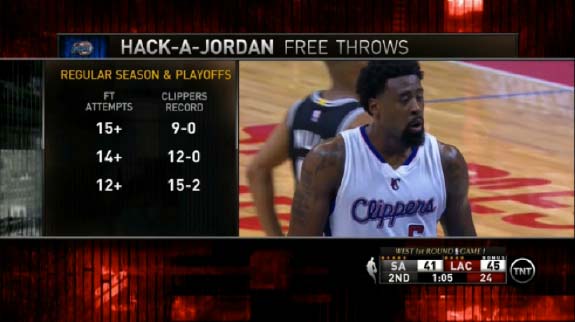Logical Fallacies and the NBA Playoffs
- by
- May 06, 2015
- LSAT, Sports
- Reviewed by: Matt Riley


We’re getting deep into the NBA playoffs. You may be tempted to avoid studying for the LSAT by watching these games, but with just about a month before the June exam, there isn’t a moment to waste. Fortunately, you can multitask and get some much-needed review of the common fallacies by paying close attention to the commentators in this series. Sports commentators fall victim to a lot of logical fallacies. This is especially true for TNT color man Reggie Miller. Here are some examples from the first-round Spurs-Clippers series …
Hack-a-Jordan
In this series, the Spurs coach Gregg Popovich frequently employed the controversial Hack-a-Jordan strategy. This involves Pop sending one of his bench-riding scrubs out to deliberately foul star Clippers center DeAndre Jordan, and send him to the free throw line for two unobstructed shots. Why do this? Well, DeAndre is an atrociously bad free throw shooter. Like, you’re-more-likely-to-see-a-representative-survey-on-the-LSAT-than-see-DeAndre-sink-a-free-throw-level-bad. Hoops fans say this strategy is bad for basketball. Instead of getting to witness DeAndre do what he does best (turn into a human flame emoji as he dunks over some poor defender), we’re forced to watch him awkwardly try to make free throws.
But Reggie Miller disagrees. See if you can spot the fallacy in his discussion with fellow commentator Kevin Harlan…
Kevin Harlan: “Now [DeAndre] Jordan in the series has gone 12/36 from the [free throw] line … “
Reggie Miller: “And I ask why wouldn’t you purposefully foul him? Of course I would. People say this isn’t good for the game. I strongly disagree.”
Reggie resorts to the super common equivocation fallacy. Reggie uses the phrase “good for the game” to refer to what is strategically advantageous for the Clippers’ opponents. But people don’t criticize the Hack-a-Jordan strategy because it’s not a wise strategic move. People argue that Hack-a-Jordan is “isn’t good for the game” because it’s super boring to watch. Since Reggie doesn’t use the phrase “good for the game” in the same way the critics would use that phrase, this argument is flawed.
More Hack-a-Jordan!
Reggie wasn’t the only one committing logical fallacies with regard to the Hack-a-Jordan gambit. The graphics whizzes at TNT threw up a chart to argue that maybe Hack-a-Jordan isn’t that smart of a strategy. The chart suggests that DeAndre Jordan throwing up a bunch of bricks from the free throw line actually causes the Clippers to win. Take a look at the chart and see if you can figure out why it might be flawed …

Looks like the TNT graphics bros got the cause and effect reversed. Teams tend to bust out the Hack-a-Jordan when they’re already losing and desperate and trying to figure out how to stop the Clippers from scoring so many points. And even though Hack-a-Jordan slows the Clips down, they end up winning anyway. So it’s not that Hack-a-Jordan causes the Clippers to win; the fact that the Clippers are about to win causes their opponents to resort to the Hack-a-Jordan strategy.
Flaw-ffensive Goaltending
The conclusion of Game 5 of the Spurs-Clippers series came down to the referees trying to determine whether DeAndre Jordan touched the ball while it was within the “cylinder” of the rim. Nudging the ball into the hoop while it’s still bouncing within the rim is considered a big no-no; the basket doesn’t count and the other team gets the ball. The refs thought DeAndre violated this rule, but they double-checked by reviewing the footage before making a game-determining call.
While refs look over the footage, commentators have to ramble on to fill airtime, which often leads to some choice logical fallacies. During this particular break, Reggie Miller wondered out loud, “Are they looking at whether [Jordan] touched the ball or are they looking at whether the ball was within the cylinder?” Can you find the fallacy in Reggie’s statement?
Sounds like Reginald committed an exclusivity fallacy. Reggie is treating these two events as if they are mutually exclusive – either the refs are looking at whether DeAndre touched the ball or they’re looking at whether the ball was bouncing within the boundary of the rim. But why wouldn’t the refs look at both of these things? It’s the refs’ job to make sure they get the call correct, so they probably wouldn’t be paying attention to only one part of the play. Kevin Harlan’s curt response that “they’re looking at it all” probably speaks to Harlan’s low opinion of Reggie’s logical acumen.
Once you really nail down the logical fallacies, you’ll start seeing them everywhere. Given that recognizing fallacies are so important to the getting a good score, spotting fallacies in the real world can only help you prepare for the LSAT!
Today’s post comes from guest blogger, Blueprint instructor and NBA superfan Ross Rinehart.
Search the Blog

Free LSAT Practice Account
Sign up for a free Blueprint LSAT account and get access to a free trial of the Self-Paced Course and a free practice LSAT with a detailed score report, mind-blowing analytics, and explanatory videos.
Learn More
Popular Posts
-
logic games Game Over: LSAC Says Farewell to Logic Games
-
General LSAT Advice How to Get a 180 on the LSAT
-
Entertainment Revisiting Elle's LSAT Journey from Legally Blonde








